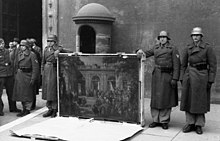
Nazi plunder (German: Raubkunst) was organized stealing of art and other items which occurred as a result of the organized looting of European countries during the time of the Nazi Party in Germany.
Jewish property was looted beginning in 1933 in Germany and was a key part of the Holocaust.[1][2][3][4][5][6] Nazis also plundered occupied countries, sometimes with direct seizures, and sometimes under the guise of protecting art through Kunstschutz units. In addition to gold, silver, and currency, cultural items of great significance were stolen, including paintings, ceramics, books, and religious treasures.
Many of the artworks looted by the Nazis were recovered by the Allies' Monuments, Fine Arts, and Archives program (MFAA, also known as the Monuments Men), following the war; however many of them are still missing or were returned to countries but not to their original owners. An international effort to identify Nazi plunder which still remains unaccounted for is underway, with the ultimate aim of returning the items to their rightful owners, their families, or their respective countries.
- ^ Cite error: The named reference
:4was invoked but never defined (see the help page). - ^ Cite error: The named reference
:5was invoked but never defined (see the help page). - ^ Cite error: The named reference
:6was invoked but never defined (see the help page). - ^ Cite error: The named reference
:7was invoked but never defined (see the help page). - ^ Cite error: The named reference
:8was invoked but never defined (see the help page). - ^ Cite error: The named reference
:9was invoked but never defined (see the help page).